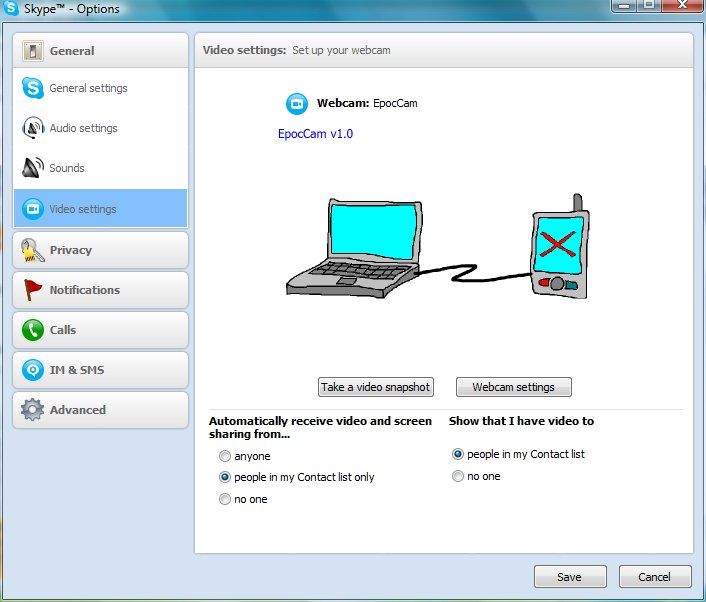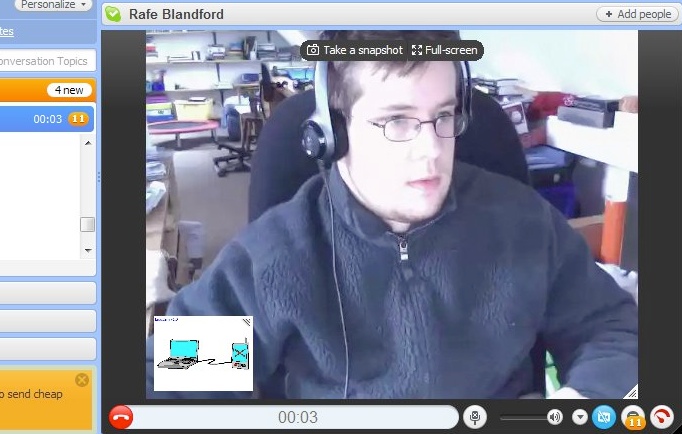Review: EpocCam Pro
Score:
70%
Turning the camera in your Symbian smartphone into a webcam for your Windows PC isn't a totally new concept, but EpocCam Pro promises easier set up and better quality than previous attempts. Pitched as an alternative to an expensive webcam, it does what it claims, although the use case for EpocCam Pro may be limited to those who travel with webcam-less Windows laptops and who want one less gadget in their bag. Read on for my review.
Buy Link | Download / Information Link
EpocCam Pro is a simple application and is easy to summarise: run it when you're connected via Ovi Suite to a Windows computer and your Symbian phone's video camera becomes available to any webcam-aware software, such as Skype, shown in the screenshots below.
Set up is quite simple, with the appropriate (small) Windows drivers also included in the main SIS download - you can install these from your phone's mass memory or memory card if you like, or simply direct from Kinoni's web site, as I did. The interface on the phone is almost non-existent, just the same cartoon image shown in the setup screens on the desktop - an overlaid cross shows when the link is inactive, but there's nothing else to do or fiddle with. Here's EpocCam Pro in place and working with Skype on my laptop:

With the drivers all in place, it's time to test EpocCam Pro, I called Rafe, as shown below. Video quality on S60 5th Edition is VGA, while this gets extended to 720 by 576 on Symbian^3 phones. Interestingly, and somewhat disappointingly, there's no pass through of audio via the phone's microphone as well - you'd have thought that a Windows computer without webcam would also be likely to not have a microphone as well. Maybe this is something the developers can add in the future.
In this case, my N97 was connected via cable, since EpocCam Pro doesn't support Bluetooth wireless connections to Ovi Suite - maybe the bandwidth isn't high enough for high quality video?

The main image above, of me, is the EpocCam Pro output on the N97 - notice that the trademark 'focussed on infinity' (read: rubbish) nature of N97-shot video is faithfully reproduced - using the utility on an N82, N95, N86 or N8 with their preset focus in video mode would produce crisper output. Having said that, for emergency use, the output was very usable and of higher quality (in terms of light handling) than on many cheaper external and built-in webcams that I've tried, especially in the PC world.
In fact, the quality of video from the expensive Carl Zeiss optics in my phone can be seen relative to the 'average' webcam Rafe was using on his Windows PC back at All About Symbian Towers, the image below shows what I was seeing on my laptop screen. Also noteworthy in the image above is the bottom left, which is what the other party sees for the first few seconds when you call up using EpocCam Pro as your web cam. You'd be using a separate microphone, mind you (see audio rant above), so you'd be able to talk immediately and then the video would kick in.

Initiating a video call or receiving one using the utility on a phone does involve a few extra steps. If you've got a camera glass protective slider (as on my N97) then you'll need to retract this (and exit Camera!). You'll also need to disable any keylock (e.g. by flicking the switch) so that the screen and general hardware are active. And, of course, you've got to start the app itself from the usual S60/Symbian menu or homescreen. It all adds up to a few extra steps and it's at this point that you start to wonder about the use case for EpocCam Pro.
Three years ago, most Windows laptops didn't have a webcam built-in, but with the popularity of Skype and MSN video, webcams are becoming more and more common, right down to the lower price points. It's true that many of these built-in units may not be up to the quality of the optics and sensor in your smartphone (depending on model!), but the built-in cams have the huge advantage that they're ready to go instantly, without:
- unlocking the phone
- starting the app
- plugging in the cable
- selecting 'PC Suite' mode
- propping up the phone at just the right angle (not easy, especially with a cable plugged in the side, adding mechanical tension)
- plugging in a separate USB or 3.5mm microphone (to handle audio)
- waiting a few seconds while the two computers talk to each other to set up the cam connection
The built-in webcams also have the advantage that they'll include the microphone for your audio, something which you'd need to buy separately if you were using EpocCam Pro.
With this utility installed and working, there's no doubting that it fulfills its mission admirably. It's just that it's hard to see a very big market for its function. If you have a Windows desktop then, even though you already own the phone and cable (and maybe even a microphone), you're still better off spending £40 for a high quality webcam that can stay in place, ready to go at a moment's notice. Convenience outweighs any possible quality gain. If you have a modern Windows laptop and travel, then use the built-in webcam (video and audio), convenience is again the bigger factor.
If you have an older Windows laptop that doesn't have a webcam built-in and you travel, then using your phone and cable (which you'd take with you anyway for syncs/backups/charging), plus a small microphone, may well be more portable and cheaper than taking along a webcam. Maybe.
Kinoni could bump up EpocCam Pro hugely by also passing along audio from the phone's microphone - this would emphasise its 'green'/travel advantages further and make it more of a recommendation. Until this happens, it's an interesting solution for a market niche.
Steve Litchfield, All About Symbian, 25 Jan 2011
PS. There's also a 'EpocCam Lite' version, for trying the functions but seeing ads for the 'Pro' version, already visible for S60 5th Edition and below but coming in the next few days for Symbian^3 phones.
Reviewed by Steve Litchfield at
